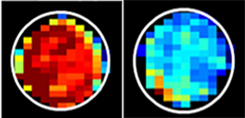MRI Technique for Detecting Cancer Could Replace Biopsies
By MedImaging International staff writers
Posted on 06 Apr 2015
A study suggests Magnetic Resonance Imaging (MRI) could be used for the noninvasive detection of cancer cells to complement or replace biopsies, without the need for injection of contrast dyes.Posted on 06 Apr 2015
Researchers at Johns Hopkins School of Medicine (Baltimore, MD, USA) tested a technique that detects sugar molecules shed by the outer membranes of cancerous cells, so far only on lab-grown cells and mice.

Image: Normal cells (left) have far more sugar attached to mucin proteins than do cancerous cells (right). Mucin-attached sugar generates a high MRI signal, shown in red (Photo courtesy of Xiaolei Song/Johns Hopkins Medicine).
The results of the study were published on online, in the journal Nature Communications on March 27, 2015.
Xiaolei Song, PhD, the lead author on the study, said, “This is the first time a property integral to cancer cells, rather than an injected dye, has been used to detect those cells. The advantage of detecting a molecule already inside the body is that we can potentially image the entire tumor. This often isn’t possible with injected dyes because they only reach part of the tumor. Plus, the dyes are expensive.
The team will next try to distinguish additional types of cancerous tumors from benign masses in live mice. If they succeed it could lead to earlier detection of cancer, new methods to monitor response to chemotherapy, and new ways to guide biopsies that may eventually make some biopsies unnecessary.
Related Links:
Johns Hopkins School of Medicine














